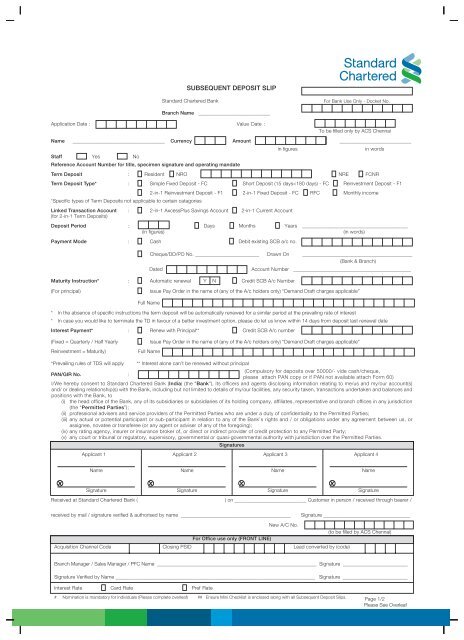Bank Deposit
Please turn on JavaScript in your browser

Ally Bank: 11 months, 0.50% APY; $0 minimum deposit. Ally Bank started in 2004 and is headquartered in Sandy, Utah. In 2009, GMAC Bank was transformed into Ally Bank. Ally Bank exceeded 1 million. Bank deposit a sum of money held on deposit with a COMMERCIAL BANK (or SAVINGS BANK).Bank deposits are of two main types: sight deposits (CURRENT ACCOUNTS), which are withdrawable on demand; time deposits (DEPOSIT ACCOUNTS), which are withdrawable subject usually to some notice being given. Direct Deposit is the best electronic payment option for you because it is: Safe – Since your money goes directly into the bank in the form of an electronic transfer, there's no risk of a check being lost or stolen. Quick – It's easy to receive your benefit by Direct Deposit.
It appears your web browser is not using JavaScript. Without it, some pages won't work properly. Please adjust the settings in your browser to make sure JavaScript is turned on.
Set up direct deposit
- Add money
- Checkbook orders
- Routing and account number
- Direct deposit
- View checks
- Overdraft Services

The fastest, safest way to deposit your paycheck
You can get a pre-filled direct deposit form or complete one yourself
Get your personalized pre-filled direct deposit form
- Sign in to chase.com or the Chase Mobile® app
- Choose the checking account you want to receive your direct deposit
- Navigate to Account Services by scrolling up in the mobile app or in the drop down menu on chase.com
- Click or tap on Setup direct deposit form
- We've pre-filled your direct deposit form to save you time
- Download, print or email the form
Complete a direct deposit form yourself:
- Download the form (PDF)
- Locate your 9-digit routing and account numbers - here's how to find them
- Fill in your other personal information
- Give the completed form to your employer
Common questions answered
What if I have U.S. government benefit income such as Social Security or military pay?
expandGo to fiscal.treasury.gov/GoDirect to enroll.

How do I set up direct deposit?
expand- Complete the direct deposit form.
- Deliver the form and a voided check to your company’s payroll department.
- If you’re eligible, your employer will deposit your paycheck directly into your account.
- Confirm the deposit each pay cycle by signing in to Chase OnlineSM or checking your account statement.
What information do I need to provide in order to set up direct deposit?
expand- Your employer or depositor’s name and address
- Your Employee ID or account number with depositor
- Your account number
- Your routing/ABA number
How quickly does direct deposit take effect?
expandDirect deposit usually takes up to two pay cycles to kick in. However, it’s different for each employer. Please check directly with your employer for specific timing.
Have more questions?
A deposit account is a bank account maintained by a financial institution in which a customer can deposit and withdraw money. Deposit accounts can be savings accounts, current accounts or any of several other types of accounts explained below.
Transactions on deposit accounts are recorded in a bank's books, and the resulting balance is recorded as a liability of the bank and represents an amount owed by the bank to the customer. Some banks charge fees for transactions on a customer's account. Additionally, some banks pay customers interest on their account balances.
Bank Deposits
Types of accounts[edit]
- Transactional accounts, known as 'current accounts' in Member states of the Commonwealth of Nations and 'checking accounts' in the United States
- A deposit account for the purpose of securely and quickly providing frequent access to funds on demand, through various different channels. Because money is available on demand, these accounts are also referred to as 'demand accounts' or 'demand deposit accounts', except in the case of NOW (negotiable order of withdrawal) accounts, which are rare checking accounts that require a seven-day notice before withdrawals.
- A deposit account that pays interest at money market rates, and for which no notice or very short notice is required for withdrawals. In the United States, they are similar to checking accounts in that they offer check-writing privileges and instant access but they are subject to the same regulations as savings accounts, including monthly transaction limits.
- Accounts maintained by retail banks that pay interest but can not be used directly as money (for example, by writing a cheque or using a debit card at a point of sale), although cash can be withdrawn from these accounts at an automated teller machine. While they are not as convenient to use as checking accounts, these accounts generally offer consumers a higher rate of interest than a transactional account and will usually be linked to a transactional account.
- Time deposit, also known as a certificate of deposit in the United States
- A money deposit at a banking institution that cannot be withdrawn for a preset fixed 'term' or period of time and will incur penalties for withdrawals before a certain date. When the term is over it can be withdrawn or it can be rolled over for another term. Generally speaking, the longer the term the higher the interest rate offered by the bank.
- Call deposit
- A deposit account that allows for the withdrawal of funds without penalty but requires a higher minimum balance to earn interest.[1]
- A deposit account in which amounts over a certain balance are automatically transferred to another account pursuant to a pre-determined set of arrangements
Bank Deposit Slips
- Automatic transfer service account
Fdic Deposit Market Share 2020
- A deposit account that allows the transfer of funds from a savings account to a checking account in order to cover a check written or to maintain a minimum balance.
- Short term deposit account
- An account where deposits are held for no longer than a year.[2]
How banking works[edit]
In banking, the verbs 'deposit' and 'withdrawal' mean a customer paying money into, and taking money out of, an account, respectively. From a legal and financial accounting standpoint, the noun 'deposit' is used by the banking industry in financial statements to describe the liability owed by the bank to its depositor, and not the funds that the bank holds as a result of the deposit, which are shown as assets of the bank.
Subject to restrictions imposed by the terms and conditions of the account, the account holder (customer) retains the right to have the deposited money repaid on demand. The terms and conditions may specify the methods by which a customer may move money into or out of the account, e.g., by cheque, internet banking, EFTPOS or other channels.

For example, a depositor depositing $100 in cash into a checking account at a bank in the United States surrenders legal title to the $100 in cash, which becomes an asset of the bank.[citation needed] On the bank's books, the bank debits its cash account for the $100 in cash, and credits a 'deposits' liability account for an equal amount. (See double-entry bookkeeping system.)
In the financial statements of the bank, the $100 in currency would be shown on the balance sheet as an asset of the bank and the deposit account would be shown as a liability owed by the bank to its customer. The bank's financial statement reflects the economic substance of the transaction, which is that the bank has borrowed $100 from its customer and has contractually obliged itself to repay the customer according to the terms of the agreement. These 'physical' reserve funds may be held as deposits at the relevant central bank and will receive interest as per monetary policy.
Typically, a bank will not hold the entire sum in reserve, but will lend most of the money to other clients, in a process known as fractional-reserve banking. This allows providers to earn interest on the asset and hence to pay interest on deposits.
By transferring the ownership of deposits from one party to another, banks can avoid using physical cash as a method of payment. Commercial bank deposits account for most of the money supply in use today. For example, if a bank in the United States makes a loan to a customer by depositing the loan proceeds in that customer's checking account, the bank typically records this event by debiting an asset account on the bank's books (called loans receivable or some similar name) and credits the deposit liability or checking account of the customer on the bank's books. From an economic standpoint, the bank has essentially created economic money (although not legal tender). The customer's checking account balance has no dollar bills in it, as a demand deposit account is simply a liability owed by the bank to its customer. In this way, commercial banks are allowed to increase the money supply (without printing currency).
Regulations[edit]
Banking operates under an intricate system of customs and conventions developed over many centuries. It is also normally subject to statutory regulations, such as reserve requirements developed to reduce the risk of failure of the bank. It may also have the purpose of reducing the extent of depositor losses in the event of bank failure.
To reduce the risk to depositors of a bank failure, some bank deposits may also be secured by a deposit insurance scheme, or be protected by a government guarantee scheme.
See also[edit]
References[edit]
- ^Call Deposit, http://www.deposits.org, accessed 2012-05-14.
- ^Short Term Deposit, International Deposit, Interest Rates Exchange. Accessed 2012-05-14.